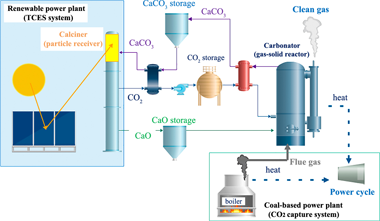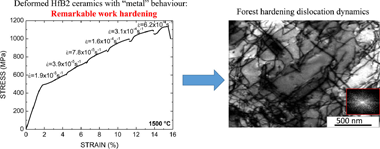Artículos SCI
2021
2021
Reactividad de Sólidos
Scaling-up the Calcium-Looping Process for CO2 Capture and Energy Storage
Ortiz, C; Valverde, JM; Chacartegui, R; Perez-Maqueda, LA; Gimenez-Gavarrell, PKona Powder and Particle Journal, 38 (2021) 189-209
Show abstract ▽

The Calcium-Looping (CaL) process has emerged in the last years as a promising technology to face two key challenges within the future energy scenario: energy storage in renewable energy-based plants and CO2 capture from fossil fuel combustion. Based on the multicycle calcination-carbonation reaction of CaCO3 for both thermochemical energy storage and post-combustion CO2 capture applications, the operating conditions for each application may involve remarkably different characteristics regarding kinetics, heat transfer and material multicycle activity performance. The novelty and urgency of developing these applications demand an important effort to overcome serious issues, most of them related to gas-solids reactions and material handling. This work reviews the latest results from international research projects including a critical assessment of the technology needed to scale up the process. A set of equipment and methods already proved as well as those requiring further demonstration are discussed. An emphasis is put on critical equipment such as gas-solids reactors for both calcination and carbonation, power block integration, gas and solids conveying systems and auxiliary equipment for both energy storage and CO2 capture CaL applications.
Octubre, 2021 | DOI: 10.14356/kona.2021005
Reactividad de Sólidos
Pure perovskite BiFeO3-BaTiO3 ceramics prepared by reaction flash sintering of Bi2O3-Fe2O3-BaTiO3 mixed powders
Taibi, A; Chaguetmi, S; Sánchez-Jiménez, PE; Perejón, A; García, JE; Satha, H; Pérez-Maqueda, LACeramics International, 47 (2021) 26947-26954
Show abstract ▽
In this work, the 0.67BiFeO(3)-0.33BaTiO(3) ferroelectric ceramic was prepared by Reaction Flash Sintering (RFS). This preparation technique combines synthesis and sintering in a single Flash experiment. The starting oxides reacted during the flash to produce a stoichiometric well-sintered solid solution at a temperature of 858 degrees C by applying a modest field of 35 V cm(-1). The process takes place in a matter of seconds, which allows obtaining a pure perovskite structure without secondary phases. X-ray diffraction (XRD) results show the mixture of rhombohedral and pseudocubic phases expected for a composition that lies within a morphotropic phase boundary (MPB) region, since a significant splitting is observed in the reflections at 2 theta values of 39 degrees and 56.5 degrees. The microstructure exhibit a peculiar bimodal grain size distribution that determines the electrical properties. As compared with previous results, flash-prepared 0.67BiFeO(3)-0.33BaTiO(3) evidences smaller grain size, as well as slightly lower remanent polarization (P-r) and smaller coercive field (E-c) under similar electric fields. It is also demonstrated that the preparation by RFS provides benefits regarding electrical energy consumption.
Octubre, 2021 | DOI: 10.1016/j.ceramint.2021.06.108
Nanotecnología en Superficies y Plasma
Photonic sensor systems for the identification of hydrocarbons and crude oils in static and flow conditions
Gil-Rostra, J; Quintero-Moreno, S; Rico, VJ; Yubero, F; Sanza, FJ; Casquel, R; Gallo-Valverde, E; Jara-Galan, ME; Sanz-Sanz, P; Holgado, M; Gonzalez-Elipe, ARSensors and Actuators B-Chemical, 344 (2021) 130265
Show abstract ▽
Identification of hydrocarbons and crude oils is typically carried out with samples that, taken from natural sources or refineries, must be brought to the laboratory for their analysis with rather sophisticated instruments. Alternatively, "in situ" procedures have been also developed for this purpose. In this work, we propose the use of a series of several sensor systems based on photonic transducers in the form of chips for the identification and classification of crude oils and hydrocarbons through the determination of their refractive index in the visible and absorption in the near infrared regions of the electromagnetic spectrum. Two of the photonic transducers rely on modifications of a Bragg microcavity and they monitor the changes in visible light interference phenomena that occur in response to the variation of the refractive index of oils. The third one, in the form of a dielectric mirror, monitors the near infrared absorption of crude oils and hydrocarbons through the recording of a transflectance spectrum. The capacity of these transducers for crude oil identification is proved by the analysis of a series of oils and distilled fractions that have been properly identified and classified as a function of their density and partition of long hydrocarbon chains. The three photonic transducers are operated with optical fibers and can be used in static and dynamic modes, this latter under conditions that are especially well-suited for "insitu" analysis of oil streams in real facilities. The proved resistance of the chips to high pressure and temperature conditions supports their suitability to withstand harsh working environments as those existing in extraction wells.
Octubre, 2021 | DOI: 10.1016/j.snb.2021.130265
Nanotecnología en Superficies y Plasma
Plasma-Assisted Deposition of TiO2 3D Nanomembranes: Selective Wetting, Superomniphobicity, and Self-Cleaning
Montes, L; Roman, JM; Garcia-Casas, X; Castillo-Seoane, J; Sanchez-Valencia, JR; Barranco, A; Lopez-Santos, C; Borras, AAdvanced Materials Interfaces (2021) 2100767
Show abstract ▽
Fabrication of tunable wetting surfaces is sought for the last years given its importance on energy, biomaterials and antimicrobials, water purification, microfluidics, and smart surfaces. Liquid management on surfaces mainly depends on the control at the micro- and nanoscale of both roughness and chemical composition. Herein, the combination of a soft-template method and plasma-enhanced chemical vapor deposition is presented for the synthesis of TiO2 nanofibers on porous substrates such as cellulose and stainless-steel membranes. The protocol, carried out under mild conditions, produces 3D nanomembranes with superhydrophobicity and oleophilicity that are tested as microliter water/oil filters. Photoactivation of TiO2 by UV illumination provides a straightforward approach for wetting tunability that converts the surface into amphiphilic. A final chemical modification of the TiO2 nanofibers by embedding them in an elastomeric polymeric shell and by fluorine-based grafting opens the path toward the formation of superomniphobic and self-cleaning surfaces with long-lasting lifetimes. Thus, a reliable procedure is demonstrated for the fabrication of TiO2 nanofibers, which allows the modification of porous supports and provides an innovative route for the development of 3D nanomembranes with under design wetting. This protocol is extendable to alternative metal oxides, metals, and core@shell nanoarchitectures with potential multifunctionalities.
Octubre, 2021 | DOI: 10.1002/admi.202100767
Propiedades mecánicas, modelización y caracterización de cerámicos avanzados
HfB2 ceramic polycrystals: A low-temperature metal-like ceramic at high temperatures?
Zapata-Solvas, E; Moshtaghioun, BM; Gomez-Garcia, D; Dominguez-Rodriguez, A; Lee, WEScripta Materialia, 203 (2021) 114037
Show abstract ▽

Hafnium diboride (HfB2) is a highly refractory (melting above 3000 degrees C) ceramic with many potential applications at high temperatures. To enable its use at temperature for extended periods its high-temperature plasticity must be known. This paper examines the mechanical response at temperatures between 900 degrees C and 2000 degrees C in air and in a reducing atmosphere, interpreting the data in the frame of classical models for the plasticity of compact-packed metals at low temperatures. In particular, the Friedel law and the principle of similitude for dislocation patterning are assessed. This reveals that HfB2 is a singular example of a ceramic material with "metal" mechanical behaviour.
Octubre, 2021 | DOI: 10.1016/j.scriptamat.2021.114037
- ‹ anterior
- 67 of 410
- siguiente ›














